
Für eine deutsche Übersetzung dieser Seite einfach die Brandenburger Flagge anklicken
 |
Click the Brandenburg Flag for a German translation Für eine deutsche Übersetzung dieser Seite einfach die Brandenburger Flagge anklicken |


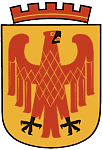 |
Home Towns - Potsdam, GermanyArchitects |
 |


| This site is part of our Potdam, Germany site. Click the left turn sign to get back to the Potsdam start site. |

|

 Many of our Potsdam sites are about buildings: castles, churches, gates, monuments and the like. Here are the people who created them. We are not trying to compete with the extensive biographies that already exist on wikipedia and other online sources, we only want to pay respect to the people who took part in the creation of this amazing town. |

 
|
Mehmet Aksoy 1939 -  Mehmet Aksoy, sometimes called the "Anatolian Michelangelo" was born in southern Turkey an is one of the country's major artists. He studied sculpture in England, Italy and Germany. Aksoy lived in Germany for many years but has recently returned to Turkey and currently works on a 390 feet high monument dedicated to peace among Turks and Armenians.  His Memorial to the Unknown Deserter at Potsdam's Unity Square is considered one of his most influential creations. |
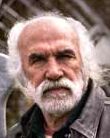
|
| Biography at Wikipedia |

 
|
Ferdinand von Arnim 1814 - 1866  Pomerania-born Ferdinand von Arnim was originally a painter who later studied architecture in Berlin under the great Karl Friedrich Schinkel. He was site foreman under Ludwig Persius and later became advisor on courtly architecture in the Potsdam department of Ludwig Ferdinand Hesse.  In Potsdam, he took part in the construction of the Church of the Redeemer in Potsdam-Sacrow under Ludwig Persius and, together with Ludwig Ferdinand Hesse, the Church of Peace. |
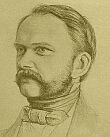
|
| Biography at Wikipedia |

 
|
Johann Peter Benkert 1709 - 1765  Potsdam's most famous sculptor Johann Peter Benkert was born in Bad Neuhaus/Bavaria and worked first as royal sculptor in Bamberg. In 1744, he moved to Potsdam and his sculptures can be found all over town.  Most notable are the sculpture groups at the Chinese Pavillion and the sculptures on top of the Knobelsdorff House, as well as the Neptune Grotto. |
sorry, no pictureX
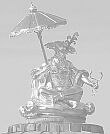
|
| Biography (in German only) at Wikipedia |

 
|
Joachim Ernst Blesendorf 1640 - 1677  Joachim Ernst Blesendorf was born in East Prussia. In 1666 he received a scholarship from Margrave Friedrich Wilhelm, and studied in Rome, Italy until 1668. In the service of the Great Elector, he designed a new suburban quarter of Berlin, later called Dorotheenstadt. He had a promising career at Frederick William's court but died 1677 in the Scanian War.  He is believed to be the builder of Potsdam's oldest, still standing building, the Preacher's Widow's House. |
sorry, no pictureX
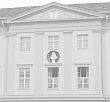
|
| Short Biography (in German only) at Deutsche Biographie |

 
|
Gottfried Böhm 1920 -  Gottfried Böhm was born on Jan. 23, 1920 in Offenbach am Main / Hessen as son and grandson of architects. He is the only German architect who was awarded the Pritzker Architecture Prize, one of the world's premier architecture prizes.  Between 2003 and 2006, Böhm built Potsdam's new State Theater, which, in its unique design, fits perfectly in the town's cosmopolitan ambience. |
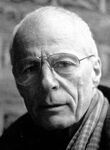
|
| Biography at Wikipedia |

 
|
Cornelius van den Bosch ?  Cornelius van den Bosch came to Potsdam around the year 1720. He was listed in the articles of the Potsdam Giants in 1726 as a master carpenter from Schipluiden near Delft in Holland. Back then, enlisted soldiers also worked in a civilian profession.  Most likely, he was one of the carpenters in charge of building the Hunters Castle at the Great Star. |
sorry, no pictureX
 
|

 
|
Cornelius Wilhelm van der Bosch ?  We could not find any online information about Dutch windmill-builder van der Bosch. The museum in the Historic Windmill might have something more.  In 1787, King Frederick William II ordered Bosh to rebuild the Historical Windmill near Sanssouci Castle. Bosch finished the job in 1791. |
sorry, no pictureX
 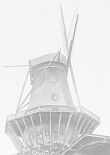
|

 
|
Johann Bouman 1706 - 1776  Dutch master-builder Johann Bouman was born on August 20, 1706 in Amsterdam / Holland. He became a licensed builder in 1730. Two years later, Prussian King Frederick William I commissioned him to design and build Dutch-styled living quarters in Potsdam. Boumann stayed in Prussia for the rest of his life and was Royal Architect for Berlin and Potsdam from 1755 until his death in 1776. Many of Berlin's most famous buildings were his design.  In Potsdam, he is best known for the Dutch Quarters (1733-1740) and the Old Town Hall at the Old Market Square (1755). He also continued and finished many of von Knobelsdorff's designs. |
sorry, no pictureX
 
|
| Biography (in German only) at Wikipedia |

 
|
Michael Philipp Boumann 1747 - 1803  Michael Philipp Boumann was born in Potsdam as the son of Johann Bouman (see above). In 1778, he was appointed Privy Building Inspector.  He worked mostly in Berlin, but left his mark in Potsdam designing the side wings of the Marble Palace. He also submitted proposals for the reconstruction of St. Nicholas Church and Belvedere Castle, but these were never carried out. |
sorry, no pictureX
 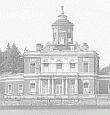
|
| Biography (in German only) at Wikipedia |

 
|
Augusto Romano Burelli 1938 -  Augusto Romano Burelli is an internationally respected architect who works mainly in his native Italy and in Germany. He graduated from the University of Venice in 1969, where he worked as a professor since 1975 and as head of the architecture department from 1991 to 1997. He also teaches at the Universities of Berlin and Dortmund and held lectures in Potsdam. In 1991, he received the "Lion of Petra" at the Architecture Biennial of Venice.  In 1996 and 97, Burelli built one of Potsdam's tallest buildings, the Senior Residency Heilig-Geist-Park. |
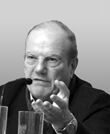
|
| Biography (in Italian only) at Wikipedia |

 
|
Johann Gottfried Büring 1723 - 1788  Unfortunately, the world knows almost nothing about this architect. Most likely, he was born in Hamburg. He went missing in 1788.  In Potsdam, he designed the Nauen Gate, the Chinese Pavillion and the Art Gallery in Sanssouci Park. He also participated in the design of the New Palace. |
sorry, no pictureX
 
|
| Biography (in German only) at PotsdamWiki |

 
|
Philip de Chiese 1629 - 1679  Philip de Chiese was born in northern Italy and was in the service of the Great Elector since 1660. He built canals and fortresses in many parts of Brandenburg and was one of the major contributors to the Berlin City Palace.  In Potsdam he worked together with Memhardt und Nehring on the City Palace. |
sorry, no pictureX
 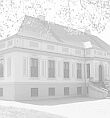
|
| Biography (in German only) at Wikipedia |

 
|
Fritz Eisel 1929 - 2010  Painter Fritz Eisel was born in Lauterbach/Hessen. He studied at the East German Art Schools of Weimar and Dresden and at the Ilya Repin Institute in Leningrad, Soviet Union. He later worked as painter in Dresden and Potsdam and spent time in Mongolia, Vietnam and India. For the last thirty years of his life, he lived in Langen Brütz, Mecklenburg.  In Potsdam, Eisel created the large mosaic Man Conquers Space at the Data Processing Center. |
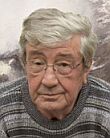
|
| Biography (in German only) at Wikipedia |

 
|
Rainer Fürstenberg 1961 -  Sculpture artist Rainer Fürstenberg was born in Potsdam. He graduated from the College of Art and Design in Halle, Germany in 1995. He received Brandenburg State's Most Promising Award for Fine Arts in 2000 and was awarded the Szpilman Award in 2004.   There are several of his sculptures in Potsdam; most prominent are his sculpture "Golden Cage" at Friendship Island and the structure he and Raiko Epperlein added to the "Neptune’s Triumph" fountain in the Pleasure Garden. |
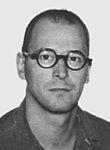
|
| Homepage (in German only) |

 
|
Pierre de Gayette 1683 - 1747  French-born Pierre de Gayette was called to Potsdam in 1720 by King Frederick William I to work on the large city Extensions conducted between 1713 and 1745. Between 1724 and 1739, de Gayette designed several buildings in Potsdam's historic center.  Gayette remained in Potsdam until his death. Many of his creations have been remodeled later but he sure left his mark, especially with the Church of the Holy Spirit, which was designed and built under his supervision between 1722 and 1725 (while the steeple was finished later by Grael). He also built the Great City School, and did the original designs of the Great Military Orphanage and the Royal Exercise Grounds. |
sorry, no pictureX
 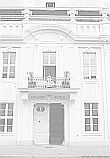
|
| No online biography available |

 
|
Philipp Gerlach 1679 - 1748  Philip Gerlach was born in Spandau near Berlin. In 1720, King Frederick William I made him Royal Building Inspector for the kings residential buildings.  As such, Gerlach mostly worked in Berlin, but he also designed the 1724 version of Potsdam's St. Nicholas Church and the Garrison Church. |
sorry, no pictureX
 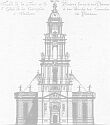
|
| Biography (in German only) at Wikipedia |

 
|
Friedrich Gilly 1772 - 1800  Architect Friedrich David Gilly was born in Altdamm, Pomerania. He is famed as prodigy and teacher of one of Germany's most famous architects, Karl Friedrich Schinkel. At the age of only 26, he was was appointed professor at the Berlin Building Academy. He died only two years later of tuberculosis and only one of his buildings (a small mausoleum in Poland) survived.  In 1797, he presented a proposal for the reconstruction of Potsdam's St. Nicholas Church, but due to his untimely death, his plans were never executed. |

|
| Biography at Wikipedia |


 
|
Friedrich Christian Glume 1714 - 1752  Berlin-born Friedrich Christian Glume was one of Potsdam's most influential sculptors.  He created the sculptures on top of the Royal Stables and all the sculptures adorning Sanssouci castle. |
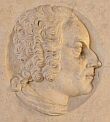
|
| Biography at Wikipedia |

 
|
Carl von Gontard 1731 - 1791  Gontard was born in Mannheim/Baden-Württemberg. Until 1764, he was royal architect in the Hohenzollern's home-residence Bayreuth/Upper Franconia. In 1764, he started working for Frederick the Great.  His most famous accomplishments in Potsdam are the Marble Palace and the New Palace. |
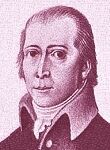
|
| Biography (in German only) at Wikipedia |

 
|
Johann Friedrich Grael 1707 - 1740  Grael was born in the East of Brandenburg. In 1725 - only 18 years old - he became Royal Archtect in Berlin. As desired by King Der im Osten Brandenburgs geborene Grael wurde bereits als Achtzehnjähriger 1725 Berliner Hofbaumeister. Auf Wunsch Frederick William I, he specialized in tall steeples. In Berlin, he designed the stepples of the Churches of St. Sophia and St. Peter.  In Potsdam, he is remembered for the 282 feet tall steeple of the Church of the Holy Spirit, which was destroyed in World War II. |
sorry, no pictureX
 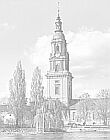
|
| Biography (in German only) at Wikipedia |

 
|
Ludwig Ferdinand Hesse 1795 - 1876  Architect and painter Hesse was born in Belgard/Pomerania and was a student of Karl Friedrich Schinkel. In 1830, he became building inspector in Berlin and from 1844 unti 1863, he was Royal Architect for King Frederick William IV. Hesse worked closely together with other pupils of the great Schinkel.  In Potsdam, he is best known for his work on the Pfingstberg Belvedere (together with Persius and Stüler). |
sorry, no pictureX
 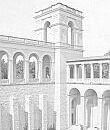
|
| Biography (in German only) at Wikipedia |

 
|
Gottlieb Heymüller 1715 - 1763  Sculptor Johann Mathias Gottlieb Heymüller was born in Steyr/Austria. 1746 he followed his brother-in-law Johann Benkert to Potsdam. Poth worked together on several projects in and around Sanssouci Park.  Most notable is Heymüller's cntribution to the more than 400 sculptures adorning the New Palace and the gold-plated statues around the Chinese Pavillion. |
leider kein BildX
 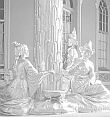
|
| Wikipedia Biographie |

 
|
Andreas Hoferick 1959 -  Sculptor and conservator Hoferick was born in Schierke, Harz and works now mainly in Berlin. Amongst other work, he restored a large number of sculptures adorning the German Reichstag.  In Potsdam, he is praised for the restatuaration of the "Caritas" sculpture on top of the Great Military Orphanage. He also restored the Pegasus sculptures at the Pfingstberg Belvedere. |

|
| Artist's homepage |

 
|
Johann Melchior Kambly 1718 - 1783  Zurich-born sculptor Kambly worked for King Frederick the Great from 1744 until the end of his life. As sculptor and furniture maker, he was one of the pivotal artists creating the Potsdam specific style of Frederician Rococo.  Kambly contributed to the sculptures adorning Sanssouci Castle and the New Palace, was the interior decorator for the King's living quarters and designed the sculptures at the entrance to the Chinese Pavilion. His last work in Potsdam was the sculpture group on top of the Royal Parade Grounds. |
sorry, no pictureX
 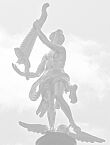
|
| Wikipedia Biography |

 
|
Rudolf Kaplunger 1746 - 1795  Sculptor Rudolf Kaplunger was born in Bohemia and did most of his artwork in Ludwigslust, Mecklenburg. Amongst others, he designed all sculptures for the castle of the Duke of Mecklenburg.  Kaplunger lived in Potsdam from about 1770 until 1777 and designed the original Caritas statue on top of the Great Military Orphanage. |
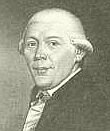
|
| Biography (in German only) at Wikipedia |

 
|
Georg Wenzeslaus Baron von Knobelsdorff 1699 - 1753  Painter and architect Georg Wenzeslaus von Knobelsdorff was born on February 17, 1699 in Crossen / Silesia. Being one of the greatest architects of his time, he designed a number of castles and public buildings in the Brandenburg Markgraviate and in Berlin.  Amongst his achievements in Potsdam are the reconstruction of the City Palace (1744-1752), Sanssouci Castle (since 1745), and the Knobelsdorff House at the Old Market Square (1750).  The Obelisk at this square bares a plaque in his honor. |
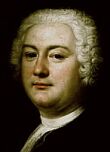
|
| Biography at Wikipedia |

 
|
Andreas Ludwig Krüger 1743 - 1822  Architect Andreas Ludwig Krüger was born in Potsdam and was the first in a 200 year-long family line of architects. He worked closely with Carl von Gontard and Gorg Christian Unger. In 1790, he became Royal Building Officer.  In Potsdam, he is hailed mostly for the interior of the Marble Pallace, for several buildings in the New Garden and for the Carriage Depot at the New Market Square. |
sorry, no pictureX
 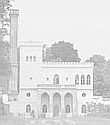
|
| Biography (in German only) at Wikipedia |

 
|
Dirck van Langelaer 1640 - 1713  Dirck van Langelaer (in Germany called Dietrich de Langelaer) was born in Wijk bij Duurstede in Utrecht/Netherlands. In 1664, he became "Planteur" (meaning tree-master) of Margrave Frederick William, who was later known as the Great Elector.  Van Langelaer became famous as the planter of over 1,500 trees in Potsdam. In 1668, he created several parkways across Potsdam. |
sorry, no pictureX
 
|
| More information at a blog in Dutch language |

 
|
Peter Joseph Lenné 1789 - 1866  No other gardener and landscape architect left a bigger mark in Potsdam than Lenné. Born in Bonn, he started working for the Prussian Royal Garden Authority in 1818 and became Royal Gardening Director in 1824. Between 1822 and 1861, he designed countless parks and gardens.  In Potsdam, Lenné gave the final touch to the parks around the castles of Sanssouci, Charlottenhof and Babelsberg. |
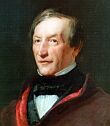
|
| Biography at Wikipedia |

 
|
Heinrich Ludwig Manger 1728 - 1790  Heinrich Ludwig Manger was born near Leipzig. In 1763, Frederick the Great appointed him Building Inspector and assigned him the project planning of Potsdam's New Palace. Only a short time later he fell from grace with the King but was later reinstated by the next King, Frederick William II.  Manger designed a large number of living quarters in Potsdam and also worked on rebuilding the Potsdam City Canal. As historian, he wrote a comprehensive History of Architecture in Potsdam. |
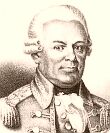
|
| Biography (in German only) at Wikipedia |

 
|
Johann Gregor Memhardt 1607 - 1678  Memhardt was born in Linz, Austria. In 1622, he went to Holland and studied the architecture of fortresses. During the Thirty-Years War, in 1838, he served Margrave George William as fortress engineer. Shortly after the war, in 1650, Margrave Friedrich Wilhelm, the Great Elector, invited him to Berlin where he soon became supervisor for all baronial buildings.  In 1660, the reconstruction of Potsdam's City Palace started under his supervision. He was also most likely the designer of the original Preacher's Widow's House. |
sorry, no pictureX
 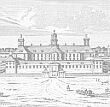
|
| Biography (in German only) at Wikipedia |

 
|
Erich Mendelsohn 1887 - 1953  Jewish German architect Erich Mendelsohn is one of the most influential architects of the 20th century. Born in East Prussia, he started working as an architect in Munich in 1912. After World War I, he settled his practice in Berlin, but had to flee Nazi-Germany in 1933.  Mendelsohn is known for his expressionist architecture, as well as for developing a dynamic functionalism in his projects.  His contribution to Potsdam, the Einstein Tower, built in 1921 is considered one of the best example of Expressionist Architecture ever built. |
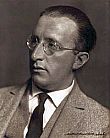
|
| Biography at Wikipedia |

 
|
Ulrich Müther 1934 - 2007  Ulrich Müther was born on the island of Rügen. Inspired by the concrete shell architecture created by Spanish architect Félix Candela, Müther became one of the world's leading experts of this style. He designed numerous buildings from the Altenberg bobsleigh track in South Germany to the King Abdullah I Mosque in Jordan.  In Potsdam, Müther built the restaurant Water Lily. |
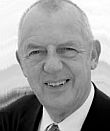
|
| Biography (in German only) at Wikipedia |

 
|
Johann August Nahl 1710 - 1781  Sculptor Johann August Nahl was born in Berlin but lived in Strasbourg most of his life. Here he initially worked for the French royal steward François Klinglin and then later on the bishopal palace of Armand-Gaston de Rohan-Soubise. In 1749, he designed and built the fountain "Neptune’s Triumph" for Potsdam's Pleasure Garden. |

|
| Biography at Wikipedia |

 
|
Johann Arnold Nering 1659 - 1695  Royal master-builder Nering was born in Prussia's Rhine Province and studied in Holland and Italy. In the service of Margrave Frederick III (who later became Prussia's first king) he built a number of the most prominent ensembles in and around Berlin, such as the Gendarme Square and, most famously, Charlottenburg Castle.  Nering who died at the age of only 36, almost left no mark in Potsdam, since his main work here, the original Royal Stables, built in 1685, were later completely remodeled by Knobelsdorff. |
sorry, no pictureX
 
|
| Biography (in German only) at Wikipedia |

 
|
Friedrich Ludwig Persius 1803 - 1845  Potsdam born architect Persius was one of the most famous students of Karl Friedrich Schinkel. He became royal building inspector in 1829 and court architect in 1841 and Royal Architectural Advisor in 1842.  Persius assisted Schinkel with the building of Charlottenhof Castle and the Roman Baths in Sanssouci Park. He also designed Potsdam's Church of Peace and the Church of the Redeemer, the Steam Pump House, called the Mosque and worked (together with Stüler and Hesse) on the Pfingstberg Belvedere. |
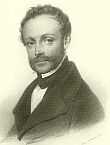
|
| Biography at Wikipedia |

 
|
Wilhelm Salzenberg 1803 - 1887  Salzenberg, born in Münster/Westfalia was also a student of Schinkel. He graduated from the Berlin Building Academy in 1834 and became royal building inspector in 1858. Salzenberg traveled several times to Konstantinopel and did reconstructive work at the famous Hagia Sofia.  In Potsdam, he designed the Church of St. Peter and Paul together with Friedrich August Stüler. |
sorry, no pictureX
 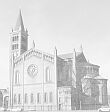
|
| Biography (in German only) at Wikipedia |

 
|
Karl Friedrich Schinkel 1781 - 1841  Prussian born architect Schinkel was the most prominent German architect of the 1800s and the best example of Neoclassicism. As head of the Prussian Building Commission, he oversaw projects in all of the expanded Prussian territories, including the then still relatively unspectacular city of Berlin.  In Potsdam, he is most famous for his collaboration with landscaper Peter Joseph Lenné. Together, the two genius architects designed the parks and castles of Charlottenhof and Babelsberg. Schinkel also designed countless houses and was responsible for the reconstruction of the Saint Nicholas Church. |

|
| Biography at Wikipedia |

 
|
Franz Heinrich Schwechten 1841 - 1924  Cologne-born architect Schwechten was one the most prominent architects of the Historism period. He was member of the Prussian Academy of Arts and worked closely with famous architects like August Stüler and Martin Gropius. Most of his work took place in Berlin, where his most famous building is the Kaiser Wilhelm Memorial Church.  In Potsdam, he built the Imperatorial War Academie on top of Brauhausberg Mountain, which is currently the seat of the State Parliament. |
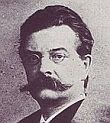
|
| Biography at Wikipedia |

 
|
Paul Emanuel Spieker 1826 - 1896  A student of Friedrich August Stüler, Spieker became one of Prussia's chief architects in the 1860s. The first building he designed was the Plötzensee Prison. In Potsdam, Spieker designed the buildings of the Royal Geodetic Institute, which is now the Albert Einstein Science Park. |
sorry, no pictureX
 
|
| Biography (in German only) at Wikipedia |

 
|
Vasily Petrovich Stasov 1769 - 1848  With his design of Potsdam's Alexandrovka, Russian architect Stasov, member of the Russian Imperial Academy of Arts became a forerunner of the Russian Revival. Later, he created countless castles and cathedrals all over the Russian Empire.  Stasov's Alexander Nevsky Church in Potsdam, built in 1829, was originally only a scale model for the much larger Church of the Tithes, which was erectet in Kiev between 1828 and 1842 under Stasov's supervision. But when the Kiev church was demolished by Soviet authorities in 1935, the tiny Potsdam church became the oldest example of the architectural period of Russian Revival. |
sorry, no pictureX
 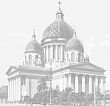
|
| Biography at Wikipedia |

 
|
Friedrich August Stüler 1800 - 1865  Stüler was born in Mühlheim/Thuringia. He was a student of Karl Friedrich Schinkel and later became one of the most influential architects of his time. He designed countless churches and public buildings all over Germany as well as in Sweden and Hungary. His masterpiece is the New Museum in Berlin.  In Potsdam, he worked on the Church of Peace (after Persius' death) and (together with Persius and Hesse) on the Pfingstberg Belvedere. |
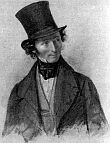
|
| Biography at Wikipedia |

 
|
Georg Christian Unger 1743 - 1799  Unger was born in Bayreuth/Upper Franconia and worked for Frederick the Great all his life. On behalf of the Prussian King he created the Citizen's Palace style. While we couldn't find a picture of the gifted architect anywhere online, we got hundreds of hits for pictures of his buildings. He built almost 100 of his Citizen's Palaces in Berlin and Potsdam; amongst them three at Potsdam's New Market Square. |
sorry, no pictureX
 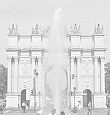
|
| Biography (in German only) at Wikipedia |

 
|
Wes & Partner WES International GmbH is a group of landscape architects, specializing in the architectural design of interior and exterior spaces, the planning of open spaces and sites and the preparation of property surveys and urban planning concepts.  In Potsdam, the firm did the overhauling of Unity Square in 2001, for which it won the prestigious Lively City Award. |
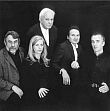
|
| Homepage |


 Back to Potsdam Page |
 Back to Home Towns |
 Back to Germany Page |
 Back to English Main Page |
 Back to Start Page |